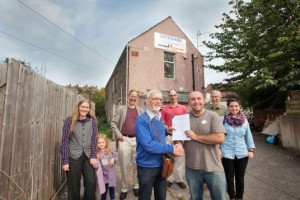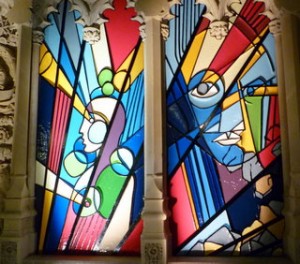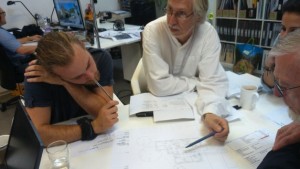Offices Into Homes – Building a theology of reconciliation
By David Mowat
This is a theological reflection on intertwined stories: an Anglican church icon called a ‘reconciliation reredos’ created for an act of historic healing, a practice of healing through dialogue called a ‘reconciliation laboratory’ and a campaign to solve the housing crisis that came out of the dialogue called ‘AEOB’. Most of the focus is on AEOB, a campaign with a practical method. Along the way is a personal story of a spiritual journey that has included Methodist, Anglican and Quaker approaches.
Why reconciliation?
Reconciliation is not an aspect of Christianity that has resonated with me naturally. I’m much more prone in my life to have believed in God’s ‘bias to the poor’ and was suspicious of ‘reconciliation’ a concept that seemed to me to be about sitting on the fence. To hell with the rich I often thought (guiltily, having had a privileged up-bringing). I worked through these ideas, and my guilt, at the Urban Theology Unit in the early 1980s under the tutelage of Rev Dr John Vincent (one-time President of Methodist Conference). He has since the 1960s kept up core Methodist traditions: anger at social injustice and grass roots-level organisation for social change. He has been a strong influence in my life.
The fate of Dives (Lk 16 v 19-31), tormented for ever in hell because he ignored the Jewish injunction to love neighbour (Lazarus) as himself suggests (I like to think) Jesus may have felt this anger too. The idea of ‘reconciliation’ sticks in my gullet, even now, when I think I see the point of it more clearly. Perhaps I’m writing (does not every act of writing attempt this?) to try and understand what it is and why it matters.
For one thing when Canon Tim Higgins -Franciscan and recent rector of Saint Stephen’s Anglican Church in Bristol- and I sat in the church garden in the late summer of 2010 and talked about what I called a ‘dialogue café’ and he called a ‘reconciliation laboratory’ I felt it was no bad thing to be swayed by the promise of collaborative work, rather than carrying on solo as I was used to.
Secondly, I had felt for a while the inadequacy of one-sided advocacy, be it from a solidarity organisation like the Palestine Solidarity Campaign premised on the unfairness meted out to a nation, the Palestinians, or even the Ecumenical Accompaniment Programme of the World Council of Churches premised on a higher principle of human rights for all. I have served on that programme in Bethlehem. I know the power and the limitation of that ‘accompanier’ identity. I was often struck by the gulf between me and others who happen to be on the other side.
For example once I was simply standing with my EAPPI jacket and note book by a check point whilst a young Israeli woman, doing her military service, was barking at Palestinians and checking their papers through a kiosk intercom. A pretty mundane non-confrontational scene in the scheme of things. When the queue had shifted she asked me with a pained expression “Why are you hurting us?”
Such advocacy (for an end to Occupation in the case of EAPPI) is necessary but it is not sufficient. How could the Israeli soldier and I, and better still the Palestinian caught in the turnstile really hear each other in a way that leads to action and builds to an alternative world? What greater field of knowing is there that sees all and holds all together compassionately? Perhaps the word ‘reconciliation’ expresses this.
After my speaking tour for EAPPI ended in 2009 I wanted to be involved in riskier dialogue than clear advocacy positions allowed, where certainty was suspended and hearts are allowed the space to feel, blindly, as they must. To help Tim by being the facilitator of reconciliation laboratories, what we came to call ‘Rec Labs,’ felt promising, not that I knew what they were.
Tim’s foundation in reconciliation seemed much more assured than mine and so I went with his name for what I felt called to develop. And now I’m exploring this thing called ‘reconciliation’ a little more carefully, not in an abstract way, but through a housing story about what is actually happening and came out of a Rec Lab event.
It is only an artifice that says a story has a beginning and an end. There is actually just a continuous stream of interconnected experience. But intelligibility demands an artifice and I chose to begin with a story of converting an office an office into a community home. Then I take the story back a little in time.
 ‘Abolish Empty Office Buildings, House People’ (referred to henceforward as AEOB) is a campaign that has its origins in a ‘Reconciliation Laboratory’ in Saint Stephen’s, a city centre Anglican church in November 2012. You can read about the group and its community share offer on www.aeobhousepeople.org.uk. (Pic shows the AEOB steering group and office owner in Sept 2014 agreeing a purchase of the group’s first property for conversion to an affordable social housing community copy right Mark Simmons).
‘Abolish Empty Office Buildings, House People’ (referred to henceforward as AEOB) is a campaign that has its origins in a ‘Reconciliation Laboratory’ in Saint Stephen’s, a city centre Anglican church in November 2012. You can read about the group and its community share offer on www.aeobhousepeople.org.uk. (Pic shows the AEOB steering group and office owner in Sept 2014 agreeing a purchase of the group’s first property for conversion to an affordable social housing community copy right Mark Simmons).
How does reconciliation work? I think it is through invitation to what sounds like an exciting event, and not through compulsion. It is through exploration of the unknown rather than the following of tested pathways and so it requires risk-taking and the ability to just be ‘all at sea’ (in ‘liminal space’ Tim Higgins calls it). At some point in the exploration it dawns on the person that what is being found feels more important than what is left behind. And ultimately it’s not down to us: something mysterious, call it Grace, call it the Holy Spirit, call it Creativity or whatever you want, is at work.
An invitation: Jesus called the rich man and hated collaborator Zachaeus down from the tree to be his host. (Lk 19 v1-10) Shocked to be snatched from the social margins to the very bosom of community, the giver of hospitality and not just the taker of taxes something in him shifted. He felt released to give half his ill-gotten gains to the poor and pay reparations to the over-taxed.
Two years ago individuals were drawn by a leaflet [below] to the city centre church of Saint Stephen’s. So far their unfolding story, led by the cry ‘Abolish Empty Office Buildings, House People!’ has touched about fifty five people who have released their wealth to purchase shares (about £240,000 to date). AEOB hope that this will release about twelve others from the poverty trap of low income-high rent as they become self-builders and residents of their first converted ex-office, in East Bristol.
Want to help make the city more equal? Whether you think you’re rich or poor, come to the Saint Stephen’s Reconciliation Laboratory and share your story. Out of these hearings we hope a ‘research’ group of rich and poor people, explore together into 2013 how honest face to face meeting leads to personal and city-wide change
“Today salvation has come to this house” says Jesus of Zachaeus. The fruit of a reconciliation is wholeness (‘salve’ can be translated as ‘be whole’) in the body of the community, divided by oppressive practices and hate.
If reconciliation is ‘the activity whereby the disorders of existence are healed, its imbalances redressed, its alienations bridged over’ (Macquarrie, John. Principles of Christian Theology SCM 1977 p 268) then what was true for Zachaeus applies equally to the work of AEOB.
Prophets of old and campaigners new castigate the rich who react by barricading themselves behind ideologies (like neoliberalism) and launch offensives which blame the poor (benefit scroungers, immigrants, yobby activists and so on). Jesus may have been an angry prophet too but was more often an enticer. To be enticed away from your money by a promise of something even more precious, is that not more effective than declaring war on the rich?1
 AEOB have been sending out their invites and offering their shares this past year (and still require more investment to complete the renovation). Their story began in a circle of people meeting in the church café which is a soft foot-fall away from what could be considered a sacred space. Methodists and Quakers may wince at the superstitious notion of sacred space but it’s still strong in Anglicanism. The space lies in front of the ‘Reconciliation Reredos’, a relief frieze, the work of both a Victorian sculptor and of African-Caribbean British artist Graeme Mortimer Evelyn (and Buddhist incidentally) on the wall behind the altar (an angel and Saint Stephen the martyr in this section).
AEOB have been sending out their invites and offering their shares this past year (and still require more investment to complete the renovation). Their story began in a circle of people meeting in the church café which is a soft foot-fall away from what could be considered a sacred space. Methodists and Quakers may wince at the superstitious notion of sacred space but it’s still strong in Anglicanism. The space lies in front of the ‘Reconciliation Reredos’, a relief frieze, the work of both a Victorian sculptor and of African-Caribbean British artist Graeme Mortimer Evelyn (and Buddhist incidentally) on the wall behind the altar (an angel and Saint Stephen the martyr in this section).
The reredos was re-modelled to celebrate the two hundred years since the abolition of the slave trade, at least a step, arguably, towards healing of the social fabric. The significance of the location is that Saint Stephen’s is the historic church by the harbour from which hundreds of slavers left for the triangular trade.
And just as AEOB want to recondition unused dead office buildings into living community, so the unloved and vandalised Victorian reredos2, hidden for years behind a curtain has been transformed into the main icon of Saint Stephen’s Church, fixing gazes towards a deeper understanding of the life and reconciling purpose of Jesus Christ.
Modern Bristol made its wealth through the slave trade horror, setting up unequal relationships in motion that continue to this day. To take one example, plantation owners compensated by the abolition of slavery twenty years on from the end of the trade were able to invest their money in newly developing industry in the city such as the Great Western Cotton Factory in Barton Hill. It paid a pittance to its workers and modelled its working day on the slave plantation system3.
Over the years the rich have stayed rich and the poor stayed poor, including, largely, the slaves’ descendants who came to Bristol as immigrants in the last century. Such structural inequality is exemplified, so the people talking and listening to each other two years ago began to see, in the line that divides house owners from house renters. That’s where AEOB started.
Central to the ‘Reconciliation Reredos’ is the curious carving of a lamb, standing tall as a stallion carrying a cross over its shoulder. The cross, an instrument of torture and symbol of the might of the Roman Empire collides with the victorious lamb, symbol of a tribe and their God in familial closeness, protected from a vengeful angel. In Jesus, a whole system of domination is subverted4. The way of ‘love your enemy’ triumphs over ‘might is right’. But reconciliation is more personal than that: the word means, in English as in the Greek, to ‘make friendly again after an estrangement’ (OED). So the way of Jesus (at least-leave aside the relationship between God and Her/His creation) allows the humanity of all, rich and poor, to be revealed and for friendship to grow.
We were a rum bunch gathering during those three blustery November night ‘laboratories’ two years ago, listening to each other and allowing something beautiful to incubate. A high-born Nigerian refugee turned cleaner and her student daughter attracted by the flyer handed to them on a pavement in Saint Paul’s district, a repentant bijou harbour-side property developer, an ex-traveller, a lonely land-lady dreaming of community and fed up with tenants taking her for a ride, an elderly woman who’d just inherited some money and an ‘involuntary millionaire’ (he told us) who’d made money through three property booms and had recently turned his Clifton mansion into a housing coop. The vision of AEOB came out of these and subsequent gatherings.
How can a vision incubate when differently empowered people gather around such a divisive issue? Drawing principally from the wisdom of silent Quaker meetings for worship and from Scott Peck5-inspired Community Building in Britain, Rec Labs form a circle inviting people to share their story. The emphasis is on listening, on speaking only when moved, on allowing discomfort and silence and mutual responsibility for the unexpected to emerge. It’s a trust-building and creative process and by and large it works. It incubated AEOB.
Away from the safety of the laboratory, does the telling of a powerful story, gentle invitation and deep listening still characterise AEOB and bring reconciliation?
Some people, drawn by the prospect of being a self-build housing coop may not recognise the description of AEOB as an experiment in ‘reconciling’ the rich and poor. Dialectical struggle not dialogue, the exposing of ‘class contradictions’, is a more common approach in activist circles. But in Christian terms, the rich but ‘unclean’tax collector Zachaeus becomes clean (or ‘saved’) through his act of repentance.
Is AEOB likewise an opportunity for restoration by the rich who feel guilty or defiled by their privileges? Arguably so.
 Reconciliation is a revolutionary act. It shortens the distance between people mediated by systems, and so does away with the need for them.
Reconciliation is a revolutionary act. It shortens the distance between people mediated by systems, and so does away with the need for them.
AEOB is, so far, a growing friendly alliance between all kinds of people, citizen-brokers, investors, self-build tenants, supportive professionals amongst others (pic AEOB steering group examining architect Chris Askew’s first plan to convert Battens Road office into flats).
Looking speculatively ahead, were things like AEOB to become multiplied in large scale, bankers would be much diminished in their power and importance and would find again their true purpose, to be of temporary service in providing liquidity. So for instance it seems as if only about 8% of the project funding will come from a bank loan.
What is true for banks is true for all the other professionals we are dealing with, whose mystique diminishes by the day, whose power-over the project reduces as we become more experienced and assertive. We’re beginning to see how the energy that comes from cooperation flows so much more easily than that which comes from compulsion.
And likewise in the New Testament, the Salvation that comes from the life and example of Jesus brings into question the Temple system or the authority of the formally-educated Scribes and Pharisees, let alone the hollow power of Rome. It is no accident that, in its first flush of deep understanding, the early church ‘held all things in common’ and so abolished the divide between rich and poor.
Methodism has long understood what we in AEOB are discovering now. For example ‘several of the Rochdale Pioneers who formed the first Co-operative Wholesale Stores at Toad Lane in 1844 were members of the Rochdale Methodist Unitarian Movement’6.
I yearn for the ‘reconciliation laboratory’ to be a method used in all kinds of conflicts, between Israel and Palestine or between rich and poor to use two examples. We are just at the start of learning how to do this.
– David Mowat Nov 14th 2014.
The writer is an advisor to Abolish Empty Office Buildings which is inviting people to buy shares from £50 to £100,000. Up to date news is on www.facebook.com/AEOBhousepeople and the share offer forms and business plan is on its website www.aeobhousepeople.org.uk. He also has a Diploma in Theology and Mission from the Urban Theology Unit and is currently seeking to develop a ‘reconciliation ministry’ at Saint Stephen’s Church Bristol where he also runs the music programme. www.saint-stephens.com. Contact him on bigbromo@yahoo.co.uk
Footnotes
- The same argument can be developed in the context of Israel and Palestine, but that might be confusing to bring in too many examples. It is only developed here in the context of the social divide between rich property owners with spare investment capital and poor people in insecure rented accommodation.
- I’m indebted to Rev Tim Higgins ‘Reconciliation Reredos’ article June 2013 for understanding its story and theology
- The writer researched the cotton factory some years before for another project. See also https://www.independent.co.uk/…/payouts-after-abolition-8508358.html
- The lamb was sacrificed and the blood smeared on the lintel so that the angel that killed all the first-born sons in Egypt ‘passed over’ (Ex 12:23). In the traditional doctrine of the atonement, Jesus is taken to be the Passover or paschal lamb. This interpretation of the Atonement is developed by Walter Wink as an effective spiritual and social transformation of ‘power as might’ e.g. in ‘The Powers That Be’ Doubleday 1998.
- Scott Peck ‘The Different Drum’ Arrow Books 1990
- From p 12 ANVIL Volume 14 No 11997 Nigel Scotland Methodism and the English Labour Movement 1800-1906